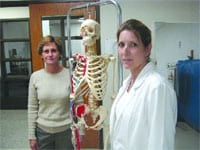Health Care’s Hidden Profession Region’s Hospitals Are Looking For A Few Good Surgical Technologists
Kate Flynn calls it “the hidden health career.”
That’s because few people actually get to see what the surgical technologist does.
Indeed, aside from the doctors and nurses in the operating room, the only person who might see this professional at work is the patient — and he or she is usually under anesthesia and thus not able to take it all in.
“These people are hidden behind doors that say positively no admittance accept for authorized personnel,” said Flynn, chair of the Surgical Technology Department at Springfield Technical Community College. “And then they’re hidden behind a mask. So few people even know they exist.”
But the surgical technologist, who hands surgeons instruments among his or her many other responsibilities, plays a key role in any surgical procedure. And that’s why the shortage of ‘techs,’ as they are called, is cause for concern in area hospitals.
Catherine Neumann, director of Surgical and Emergency Services at Cooley Dickinson Hospital in North-ampton, said vacancies can take a year to fill, leaving her hospital and others forced to shuffle existing personnel and rely on more on-call techs.
She said that unless more techs can be brought into the market, hospitals will eventually have to rely on people who are either overqualified or underqualified to do the same work.
And as bad as the problem is now, it will get even worse when those currently in the profession — most of them in their 40s and 50s — reach retirement age, she said. “I’m not sure where the people we’ll need to fill those positions are going to come from.”
There are many theories about why the shortage exists and so few people are getting into the surgical technology field. First, there’s the pay, which, while not low, at $12 to $15 to start, is not as high as other professions in the industry. Other factors include the nature of the work — many people simply don’t like watching surgical procedures — the accompanying stress, and possible long hours.
But the prevailing theory is that simply not enough people even know the profession exists.
Thus, area hospitals and STCC are trying to get the word out, through everything from radio commercials to work with high school guidance counselors, to inform them of this exciting field.
This educational effort is ongoing, said Neumann, who told The Healthcare News that the rewards of the hidden profession must come out into the open.
The Job at Hand
The surgical technologist, as a medical profession, dates back to World War II, said Flynn. A shortage of doctors and nurses made it necessary to place an individual in the field hospital to assist doctors and other surgical personnel.
Today, the role of the tech remains much the same, with duties before, during, and after a surgical procedure. These individuals help set up the operating room with surgical instruments and equipment, sterile linens, and sterile solutions. They also prepare patients for surgery by washing, shaving, and disinfecting incision sites. In addition, techs transport patients to the operating room, help position them on the operating table, and also observe patients’ vital signs, check charts, and help the surgical team scrub and put on gloves, gowns, and masks.
During surgery, in addition to passing instruments to surgeons and their assistants, techs may hold retractors, cut sutures, count sponges and instruments, and help operate diagnostic equipment.
All this is a challenging, sometimes exciting job, said Neumann, one that provides plenty of variety. And there is room for advancement. Indeed, many surgical technicians often become what are known as “first surgical assistants,” individuals who perform more involved tasks, such as suturing and holding back tissue while the surgeon performs a procedure.
As for the pay, it’s getting better, and with the shortages that exist at area hospitals, there are ample opportunities to earn more money working in an on-call capacity, she said.
So why aren’t more people attracted to the profession?
Neumann and Flynn say much of it boils down to awareness.
“We have to let more people know about these positions,” said Neumann. “People are not being educated about them in high school, and that’s something we have to work on.”
Roberta Hughes, a surgical technologist at Wing Memorial Hospital and a graduate of the STCC program, said that when she shifted gears at the school and moved from the physical therapist assistant program to surgical technology, she had a hard time explaining to her husband and friends what she was getting into.
“That’s part of the problem … no one knows about this field or what the technologist does,” she said. “And they should — this is an important job.”
Hughes said Wing currently has a full roster of surgical technologists, a state that doesn’t exist often. Vacancies occur frequently, she said, in part because of the high demand for techs, which enables those in the field to repeatedly move to better jobs. And the vacancies are hard to fill, with ads for the open positions generating very few responses.
Hughes said the prognosis will improve only if hospitals ante up and increase the wage scales for the position. She said she has seen some movement in that area, but not enough.
Ultimately, hospitals will pay a price if more people don’t get into the field, she said, because they will then have to rely on nurses to perform those tasks — and there is already a nursing shortage — or “take people off the street and train them to do it, as they did years ago.”
Either way, patient care is likely to be impacted, she said, expressing the hope that through education, this hidden health career will lose its anonymity.


